- Clinical Technology
- Adult Immunization
- Hepatology
- Pediatric Immunization
- Screening
- Psychiatry
- Allergy
- Women's Health
- Cardiology
- Pediatrics
- Dermatology
- Endocrinology
- Pain Management
- Gastroenterology
- Infectious Disease
- Obesity Medicine
- Rheumatology
- Nephrology
- Neurology
- Pulmonology
Suspicious Skin Lesions and Secondary Syphilis
Syphilis took Europe by storm at the end of the 15th century in what was to become a sweeping epidemic. Before 1495, it was unknown or perhaps was attributed to other disease processes, such as leprosy.
Key words: Secondary syphilis, Erythema multiforme, Rocky Mountain spotted fever
Syphilis took Europe by storm at the end of the 15th century in what was to become a sweeping epidemic. Before 1495, it was unknown or perhaps was attributed to other disease processes, such as leprosy. Some theorize that Christopher Columbus and his crew brought the causative organism, Treponema pallidum, into Europe from the New World during the so-called Age of Discovery. Recent research, however, suggests that treponemal disease of lesser virulence (eg, yaws) existed in both the Old and New Worlds and that the syphilis epidemic that struck Europe at the turn of the 16th century may have been caused by a mutation of a New World treponemal pathogen that was introduced into the Old World.1
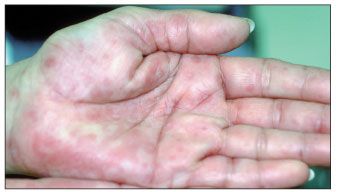
Figure 1 –Erythema multiforme may be confused with secondary syphilis. The initial lesions manifest as erythematous macules or urticarial plaques that often involve the face, neck, and palms. The lesions evolve into an iris, or target, lesion. (Photo courtesy David Effron, MD.)
Development of an effective vaccine has been elusive. Although effective treatments-with penicillin G remaining the gold standard-are available and although modern Americans generally know the names and mechanics of most sexually transmitted diseases, the incidence of syphilis has been steadily increasing in the United States since 2000, when the rates of primary and secondary syphilis were at their lowest in nearly 60 years.2
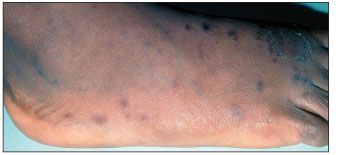
Figure 2 –Pityriasis rosea can be mistaken for secondary syphilis. It typically erupts on the back as a pinkish, scaly, oval plaque but can occur anywhere on the body. Hypopigmentation or hyperpigmentation may occur as the rash resolves. (Photo courtesy David Effron, MD.)
Nearly 37,000 cases of syphilis were reported to the CDC in 2006 and nearly 41,000 were reported in 2007.2 Between 2005 and 2006, the incidence of primary and secondary syphilis increased by 13.8%.3 Between 2006 and 2007, the rate increased by 17.5%.2
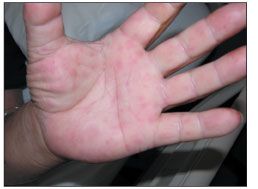
Figure 3 –The macular, nonpruritic, erythematous rash of Rocky Mountain spotted fever develops on the hands and soles of many patients, causing it to be confused with secondary syphilis. Like syphilis, the initial symptoms of infection before manifestation of the rash may include headache and fever. (Photo courtesy Brett Mikeska, MD, and Sunil Patel, MD.)
Those most affected are persons aged 25 to 29 years, and men are significantly more affected than women.2 Those at highest risk are men who have sex with men.2 In 2006, 64% of the cases of primary or secondary syphilis occurred in this population group.4
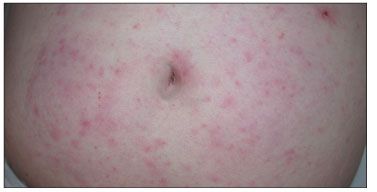
Figure 4 –A diffuse rash consisting of small, pink macules characteristic of Rocky Mountain spotted feveris shown on a patient’s abdomen. (Photo courtesy Brett Mikeska, MD, and Sunil Patel, MD.)
Chancre formation, often in the genital area, is the characteristic sign of primary syphilis. It is usually painless and may be accompanied by mild regional lymphadenopathy. It typically manifests 2 to 6 weeks after sexual exposure and heals within 4 to 6 weeks. If left untreated, secondary syphilis ensues, which can progress to latent and tertiary disease. Data from the CDC suggest that most cases of syphilis come to the attention of health care providers when the disease is in its secondary stage.2
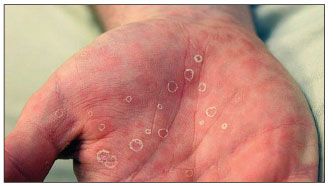
Figure 5 –This macular rash on the palms of a 24-year-old HIV-positive man is typical of secondary syphilis. (Photo and case courtesy of David Lubin, MD.)
Persons with secondary syphilis often first present with constitutional symptoms such as headache, sore throat, fever, loss of appetite, fatigue, and malaise. The GI tract; CNS; or renal, musculoskeletal, or ophthalmological system may be involved. Telltale cutaneous lesions often manifest on the palms, soles, and face and may be papular, macular, pustular, plaque-like, or a combination. Differential diagnoses include drug eruptions, erythema multiforme (Figure 1), guttate psoriasis, lichen planus, pityriasis rosea (Figure 2), Rocky Mountain spotted fever (Figures 3 and 4), scarlet fever, and various other diseases that manifest as skin lesions.
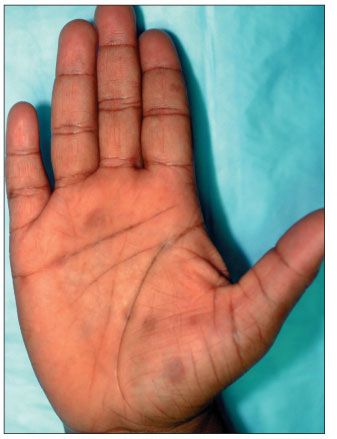
Figure 6 –Compare this palmar rash, attributed to secondary syphilis, with that in Figure 1, depicting erythema multiforme. (Photo and case courtesy David Effron, MD.)
Figure 5 illustrates a palmar macular rash that is typical of secondary syphilis. The rash developed over 2 weeks in a 24-year-old, HIV-positive man. It was neither pruritic nor painful. The patient also had a brighter, more inflamed rash in the groin and antecubital fossae that had been diagnosed as a yeast infection. He had a history of tonsillitis and “stress-related fatigue” for which bupropion was prescribed. Given this information, secondary syphilis was suspected. Results of a rapid plasma reagin (RPR) test were positive, with a titer of 1:128.
The lesions on the palm and sole depicted in Figure 6 and Figure 7, respectively, occurred in a 36-year-old woman. She reported that the lesions had developed within the week before presentation. She denied recent illness, pruritus, fever, chills, sore throat, or abdominal discomfort and was in a monogamous relationship. Nevertheless, secondary syphilis was suspected. Serological test results were positive.
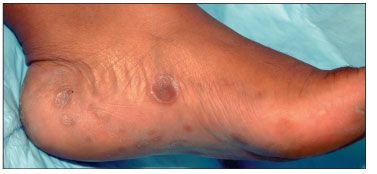
Figure 7 –Compare this plantar rash, attributed to secondary syphilis, with that in Figure 2, depicting a manifestation ofpityriasis rosea. (Photo and case courtesy David Effron, MD.)
The sudden appearance of multiple nonpruritic lesions on the forearms (Figure 8) and hands of a 20-year-old woman eventually prompted her to seek medical care. She reported that the lesions had emerged 2 weeks earlier. They were erythematous annular macules and papules. A biopsy specimen demonstrated scattered plasma cells, hyperkeratosis, parakeratosis, and aggregates of mononuclear cells in the papillary dermis-findings that were representative of secondary syphilis. Results of a VDRL test were positive, and the patient was treated with penicillin G benzathine and penicillin G procaine.
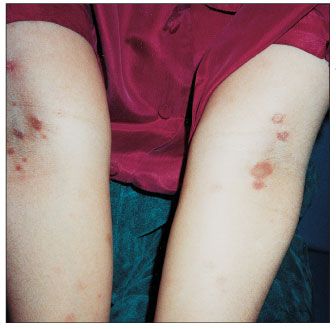
Figure 8 –Secondary syphilis manifested in this patient as numerous annular, nonpruritic, erythematous macules and papules on the hands and forearms. (Photo and case courtesy Jonathan S. Crane, DO, Mary Lou Courreg, MD, and David Ohashi, MD.)
Figure 9 depicts a typical palmar rash in a sexually active teenaged boy who claimed to be diligent in condom use. The rash began on his hands and spread to his torso and upper extremities. Two weeks before the lesions appeared, the patient experienced fatigue, fever, and myalgia that persisted for a week. Results of a RPR test were positive, with a titer of 1:64. Results of an HIV test also were positive. The patient was treated with 3 weekly injections of 2.4 million units of penicillin G benzathine. Because of his HIV-seropositive status, he received aggressive follow-up to monitor for treatment failure, and he was referred to an adolescent HIV clinic for initiation of antiretroviral therapy and support.

Figure 9 –A telltale rash characteristic of syphilis appeared on the palms of a sexually active teenaged boy who also was found to be seropositive for HIV. (Photo and case courtesy of David Schwartz, MD, and Sarah Taylor, MD.)
The skin eruption depicted in Figure 10 was widespread, uniform, and characterized by 3- to 5-mm, moderately firm intradermal papules. The eruption developed over the course of a month on the trunk and extremities of a 55-year-old man. The palms, soles, and intertriginous areas were spared.
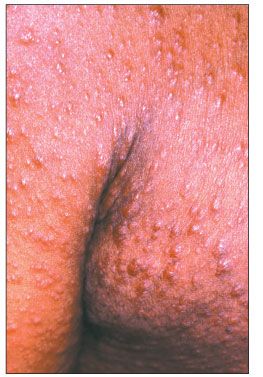
Figure 10 –A slightly pruritic rash characterized by uniformly distributed 3- to 5-mm papules is shown in the right axillary area of a 55-year-old man in whom secondary syphilis was diagnosed. (Photo and case courtesy of Joe Monroe, PA-C.)
The patient was not taking any new medications and initially denied new sexual contacts or sexually risky behaviors. Laboratory tests showed no evidence of dyslipidemia, diabetes, or autoimmune disease. Biopsy results ruled out the differential diagnoses of granuloma annulare, sarcoidosis, eruptive xanthoma, and lichen planus. Histological examination demonstrated numerous plasma cells, which raised the suspicion of syphilis.
Presented with this information, the patient admitted to extramarital heterosexual contact several months earlier. The results of RPR and fluorescent treponemal antibody absorption tests and a microhemagglutination assay for antibody to T pallidum confirmed the diagnosis of syphilis. Intramuscular benzathine penicillin G, 2.4 million units, was given.
References:
REFERENCES
1. Harper KN, Ocampo PS, Steiner BM, et al. On the origin of the treponematoses: a phylogenetic approach. PLoS Negl Trop Dis. 2008;2:e148.
2. Centers for Disease Control and Prevention. Sexually Transmitted Disease Surveillance, 2007: Syphilis. http://www.cdc.gov/std/stats07/syphilis.htm. Accessed February 6, 2009.
3. Centers for Disease Control and Prevention. Surveillance 2006 National Profile: Syphilis. http://www.cdc.gov/std/stats06/syphilis.htm. Accessed February 6, 2009.
4. Beltrami JF, Weinstock HS. Primary and secondary syphilis among men who have sex with men in the United States, 2006. Presented at: the 17th Biennial meeting of the International Society for Sexually Transmitted Diseases Research; July 29-August 1, 2007; Seattle.
